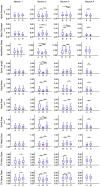Distribution of spine classes shows intra-neuronal dendritic heterogeneity in mouse cortex
- PMID: 39712647
- PMCID: PMC11657875
- DOI: 10.1117/1.NPh.12.1.015001
Distribution of spine classes shows intra-neuronal dendritic heterogeneity in mouse cortex
Abstract
Significance: Neuronal dendritic spines are central elements for memory and learning. Their morphology correlates with synaptic strength and is a proxy for function. Classic light microscopy cannot resolve spine morphology well, and techniques with higher resolution (electron microscopy and super-resolution light microscopy) typically do not provide spine data in large fields of view, e.g., along entire dendrites. Therefore, it remains unclear if spine types are organized on mesoscopic scales, despite their undisputed importance for understanding the brain.
Aim: Recently, it was shown that the distribution of spine type is dendrite-specific in the turtle cortex, suggesting a mesoscopic organization, but leaving the question open if such a dendrite specificity also exists in mammals. Here, we determine if such a difference in spine-type distribution among dendrites also exists in the mouse brain.
Approach: We used super-resolution stimulated emission depletion microscopy of complete dendrites and advanced morphological analysis in three dimensions to decipher morphological differences of spines on different dendrites.
Results: We found that spines of different shapes decorate different dendrites of the same neuron to a varying extent. Significant differences among the dendrites are apparent, based on spine classes as well as based on quantitative descriptors, such as spine length or head size.
Conclusions: Our findings may indicate that it is an evolutionarily conserved principle that individual dendrites have distinct distributions of spine types hinting at individual roles.
Keywords: dendrite-specific; dendritic spine; spine morphology; spine shape; super-resolution stimulated emission depletion microscopy; three-dimensional analysis.
© 2024 The Authors.
Figures





Similar articles
-
STED microscopy reveals dendrite-specificity of spines in turtle cortex.Prog Neurobiol. 2023 Dec;231:102541. doi: 10.1016/j.pneurobio.2023.102541. Epub 2023 Oct 26. Prog Neurobiol. 2023. PMID: 37898315
-
Ultrastructural analysis of dendritic spine necks reveals a continuum of spine morphologies.Dev Neurobiol. 2021 Jul;81(5):746-757. doi: 10.1002/dneu.22829. Epub 2021 May 30. Dev Neurobiol. 2021. PMID: 33977655 Free PMC article.
-
Geometry and the Organizational Principle of Spine Synapses along a Dendrite.eNeuro. 2020 Oct 27;7(6):ENEURO.0248-20.2020. doi: 10.1523/ENEURO.0248-20.2020. Print 2020 Nov-Dec. eNeuro. 2020. PMID: 33109633 Free PMC article.
-
The integrative properties of spiny distal dendrites.Neuroscience. 1992;47(3):495-519. doi: 10.1016/0306-4522(92)90161-t. Neuroscience. 1992. PMID: 1584406 Review.
-
The function of dendritic spines: a review of theoretical issues.Behav Neural Biol. 1985 Sep;44(2):151-85. doi: 10.1016/s0163-1047(85)90170-0. Behav Neural Biol. 1985. PMID: 2415102 Review.
Cited by
-
Seizure network characterization by functional connectivity mapping and manipulation.Neurophotonics. 2025 Jan;12(Suppl 1):S14605. doi: 10.1117/1.NPh.12.S1.S14605. Epub 2025 Jan 16. Neurophotonics. 2025. PMID: 39822587 Free PMC article.
References
LinkOut - more resources
Full Text Sources

